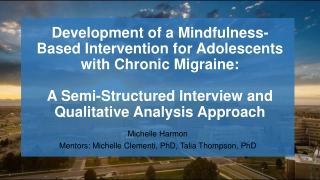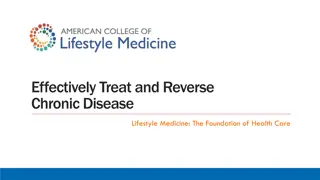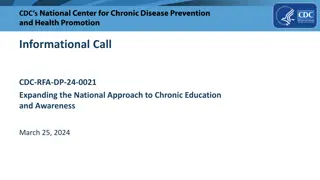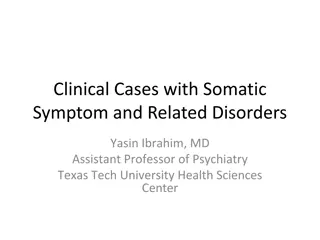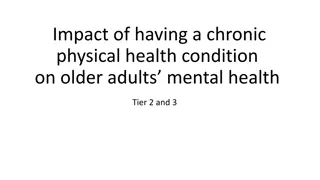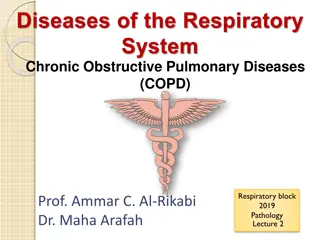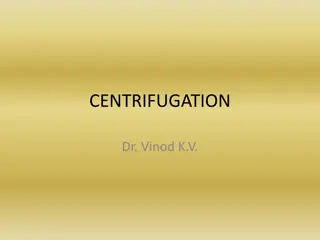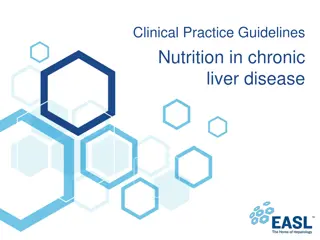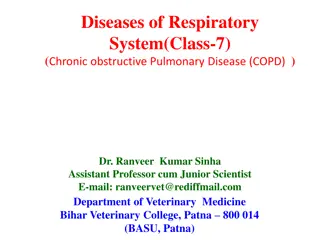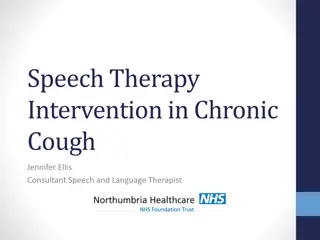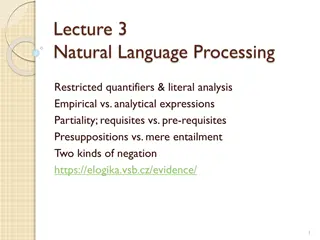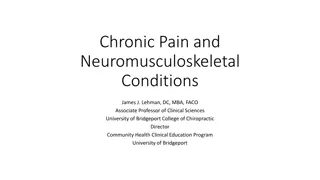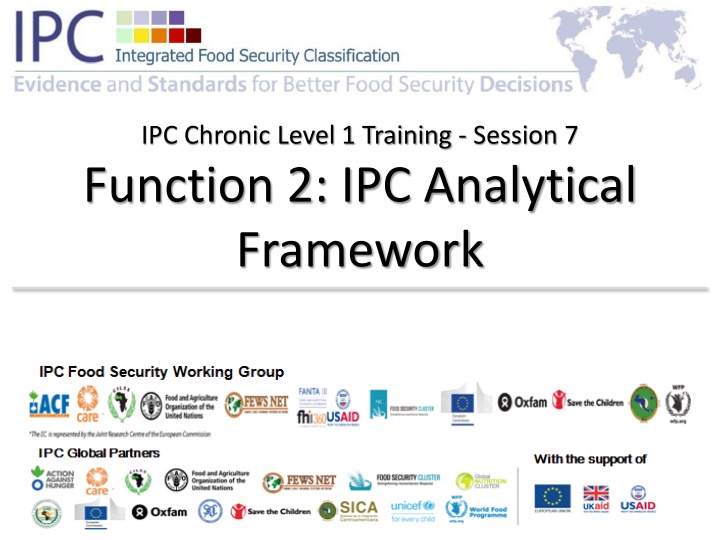
IPC Analytical Framework for Food Security Training Overview
Explore the IPC Analytical Framework for Food Security Training, covering conceptual frameworks, risk assessment, sustainable livelihoods, food security dimensions, and malnutrition analysis. Enhance skills in framework identification, factor analysis, severity classification, and evidence integration.
Uploaded on | 3 Views
Download Presentation

Please find below an Image/Link to download the presentation.
The content on the website is provided AS IS for your information and personal use only. It may not be sold, licensed, or shared on other websites without obtaining consent from the author. If you encounter any issues during the download, it is possible that the publisher has removed the file from their server.
You are allowed to download the files provided on this website for personal or commercial use, subject to the condition that they are used lawfully. All files are the property of their respective owners.
The content on the website is provided AS IS for your information and personal use only. It may not be sold, licensed, or shared on other websites without obtaining consent from the author.
E N D
Presentation Transcript
IPC Chronic Level 1 Training - Session 7 Function 2: IPC Analytical Framework IPC Food Security Working Group IPC Global Partners
Learning Objectives By the end of this session, participants should be able to: Identify and describe the four conceptual frameworks used to build the IPC Analytical Framework List and explain contributing factors & outcome elements within the IPC Analytical Framework Describe how the IPC Analytical Framework guides classification of severity & identification of causes Demonstrate where wide-ranging evidence fits in the IPC Analytical Framework 2
Four Common Conceptual Frameworks 1. Risk, Hazard & Vulnerability Framework 2. Sustainable Livelihood Framework 3. Four dimensions of Food Security 4. UNICEF Conceptual Framework for Malnutrition 3
Risk, Hazard & Vulnerability Framework = f f Hazard & Vulnerability Risk In relation to specific hazards: Exposure: Experience of hazards Susceptibility: Ways the system is affected by hazards Resilience: Ability to withstand a hazard and return to previous conditions Damaging phenomenon that can be: Natural or human- induced Acute/sharp or chronic/on-going Probability or actual negative results/impacts of losses Seen in terms of: Probability Severity Magnitude Analyzed in terms of: Livelihood Strategies: Food & income sources, usual coping & expenditures Livelihood Assets: 5 capitals Policies, Institutions, and Processes 3/18/2025 IPC Learning Programme 4
The Four Dimensions of Food Security Availability Utilization Access Stability 6
UNICEF Conceptual Framework for Malnutrition Malnutrition Inadequate Food Intake Immediate causes Disease Access to Health Care & Health Environment Household Food Security Social & Care Environment Underlying causes Formal & Informal Infrastructure Political Ideology Resources Basic causes IPC Learning Programme 7
Identify the Appropriate Framework Exercise 7.1 Task: With a partner... 1. Read the 4 mini-cases 2. Discuss which of the frameworks can guide us in trying to understand the status of food insecurity as indicated by each of the following mini-cases 3. Try to focus on the most directly related. However, there may be more than one framework which applies to a mini-case. 8
Exercise 7.1 Case #1 1. Reports indicate chronic malnutrition (stunting) rates are over 40% in the north. UNICEF Conceptual Framework for Malnutrition 9
Exercise 7.1 Case #2 2. There are large volumes of maize in the markets throughout the year but a limited variety of vegetables during most of the year. 4 Dimensions of Food Security Framework 10
Exercise 7.1 Case #3 3. Farm households with irrigated fields appear to be the ones with most sustainable and resilient livelihoods, and these usually have various assets and medium and large-scale animal holdings. Households dependent on rain-fed crops have to deal with arid climate, poor soils and recurrent droughts and thus have less resilient livelihoods and own less assets. Risk Hazard & Vulnerability Framework Sustainable Livelihoods Framework 11
Exercise 7.1 Case #4 4. Because of the lack of economic opportunities, most income opportunities in the area relate to agricultural casual labour. This means that wage income of landless households is very low, dependent on agricultural season, and usually not enough to purchase adequate quantities of food. Many, as a result, are unable to meet their food requirements and stunting levels are very high (over 45%). Risk, Hazard & Vulnerability Framework Sustainable Livelihoods Framework Four Pillars of Food Security UNICEF Nutrition Framework 12
IPC Analytical Framework Builds from and integrates the 4 commonly used conceptual frameworks Shows relationships between the frameworks and various FS elements Guides the convergence of evidence for overall classification of severity and identification of causes IPC Manual Applies to analysis of both acute and chronic food insecurity 13
IPC Analytical Framework Food Security Contributing Factors Contributing factors are used to: Infer Food Security Outcomes Triangulate Food Security Outcomes Determine whether mortality, nutrition, and livelihood change outcomes have food security drivers Determine key factors influencing food insecurity 15
IPC Analytical Framework Food Security Contributing Factors (cont.) Causal Factors: Uses the Risk, Hazard and Vulnerability & Sustainable Livelihoods Frameworks, including: Vulnerability Hazards Impact Food Security Dimensions: Are directly impacted by the interaction of vulnerabilities & hazards and include: Availability Access [Physical] Utilization Stability 16
IPC Analytical Framework Food Security Outcomes Comparability: Outcomes are generally comparable irrespective of contexts International standards: Analysis done with reference to globally accepted thresholds Primary & Secondary Outcomes: 1 Outcomes: Any food insecurity must be expressed as food consumption and/or livelihood change 2 Outcomes: Nutrition and/or Mortality are only expressed following 1o outcomes Exclusive and Non-Exclusive Outcomes: Exclusive to Food Security: Food consumption (Represented by grey box) Non Exclusive to Food Security: Livelihood change, Nutrition and Mortality (Represented by partially shaded box) 17
IPC Analytical Framework Contributing Factors and Outcomes Feedback Loop: Changes in FS Outcomes can lead to changes in Contributing Factors Worsening or improving vulnerability and/or acute events or chronic conditions Consequently leading to impacts on FS dimensions Interactions between Contributing Factors: Result in FS outcomes (positive or negative changes) 18
How the Framework Guides Analysis & Classification Guides where to situate the evidence and to see the relationships between pieces of evidence Classification done based on convergence of all available evidence, including contributing factors and outcomes Intentionally comprehensive, however, evidence is not required for each element to classify Analysis can be done with whatever at least somewhat reliable evidence is available, and best use of available information is made through convergence however, in order to classify and map the results certain minimum requirements have to be met 19
Place Evidence in the Appropriate Place in the Framework Exercise 7.2 Task: With a partner... 1. You will be given 10 minutes to discuss the evidence provided in the workbook and to determine where the piece of evidence best fits in the IPC Analytical Framework. 2. When you have reached an agreement, write the correct answers in the workbook, and be ready to share your results in plenary 20
Wrap Up Do you feel you can .? Identify and describe the four conceptual frameworks used to build the IPC Analytical Framework List and explain contributing factors & outcome elements within the IPC Analytical Framework Describe how the IPC Analytical Framework guides classification of severity & identification of causes Demonstrate where wide-ranging evidence fits in the IPC Analytical Framework 21

